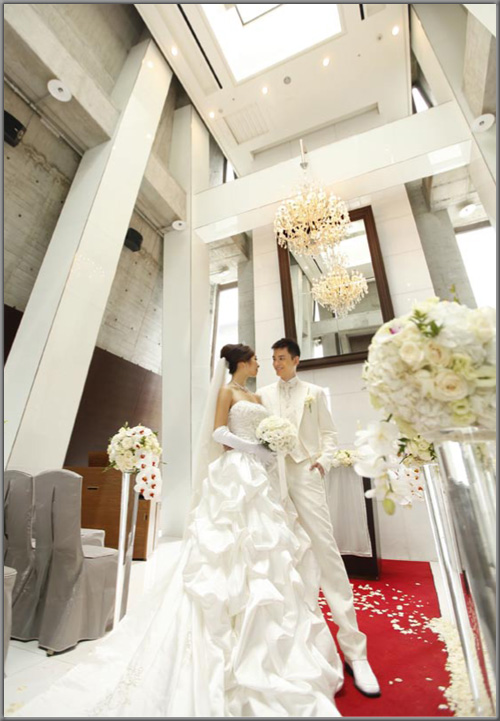Home > Highlighting JAPAN > Highlighting Japan FEBRUARY 2012 > At Your Service
Highlighting JAPAN
COVER STORY: At Your Service

Caption: Watabe Wedding now holds wedding ceremonies outside Japan, in chapels in Singapore,
Taiwan, Shanghai and, pictured, Hong Kong.
Credit: COURTESY OF WATABE WEDDING
At Your Service
Until now, those Japanese companies actively engaged in overseas business were mostly manufacturers. In recent years, however, they have been joined by companies in the service industry. The types of business are wide-ranging, and include retail, restaurant, education and transport. This month's Cover Story introduces some Japanese people and companies that are making a contribution to the lives of people in the countries where they operate on the basis of Japanese-style customer service, providing the meticulous customer care that has been cultivated in Japan.
Weddings in Japan are generally ceremonies in which the couple exchange marriage vows in front of a Shinto priest in a shrine, a Buddhist priest in a temple, or a pastor or priest in a chapel. Most people in Japan attach importance to saying the wedding vows in front of family and friends, moving to a hotel or restaurant after the ceremony for a reception. Whereas attendance at the ceremony is limited to family, relatives and close friends, invitations to the reception extend more widely to include workplace superiors and acquaintances. The average number of guests invited is around eighty.
At the reception, the bride and groom cut the wedding cake, workplace superiors and friends make congratulatory speeches, and friends enliven the event by providing various entertainment. The production includes elements such as lighting, visuals (often photographs are shown of the bride and groom from their childhood up to the wedding), and music, until the party is finally wound up with the groom's speech and a few words of thanks from the groom's father to the guests.
From the 1990s there has also been a sharp increase in the number of Japanese holding their wedding at a church overseas, combining it with the honeymoon. Watabe Wedding has been the driving force behind that trend.
Established in 1953 in Kyoto as a dress hire business, the company began conducting weddings in Hawaii as early as 1973. Today it has bases in thirty-five overseas locations including North America, Europe and Australia, and eighty-two locations in Japan. While in the past these were all aimed at Japanese couples, the company decided to branch out by commencing a service aimed at couples in other parts of Asia.
"Rapid economic growth is resulting in dramatic changes to lifestyles in other Asian countries, including culture. We gauged that, given time, the changing trend of ceremony style that we had seen in Japan would also happen in other parts of Asia, and that Japan's customer service culture would be well-received locally," says Makoto Fujibayashi, business development manager of Watabe Wedding's Asian Business Division.
Starting with Hong Kong in 2007, the company began a service coordinating overseas weddings in Taiwan and Shanghai, and from 2010 began operating wedding centers in Taiwan and Singapore.
"If we brought in the Japanese service in exactly the same format it would never succeed. The key is how to develop a service tailored to the locality, conducting thorough on-the-ground research, gathering customer views through surveys and so forth," says Fujibayashi.
According to Fujibayashi, weddings in other Asian countries have something in common. Unlike Japan, there is no custom of holding a ceremony in a place with religious significance, with many weddings consisting only of a reception in a hotel, restaurant or such like. Though the guest list is much longer than that in Japan, there are no specific elements that must be included, with most receptions consisting simply of a meal.
So in Taiwan Watabe Wedding produces a wedding that incorporates a ceremony in a chapel in addition to the reception. The ceremony is not religious, however, but rather a mutual pledging of love in front of those present.
"The major theme of our service is the desire to touch the hearts not only of the couple but of all those in attendance. A ceremony is held in a chapel where they mutually pledge their love, and then move on to the reception where the ambience is heightened. The reception is a show staged for everyone's enjoyment that alternates between appeal to the emotions, and a sense of celebration."
Despite the fact that this custom is not traditional in Taiwan and Singapore, the ceremony in the chapel is extremely popular, with the majority of couples wishing to have a ceremony as well as a reception. The rapid spread of the Internet has meant that guests' impressions can now be conveyed instantly through Twitter, Facebook and other social media, with comments such as "I was really touched by the smiling faces of the bride and groom," or "It was lovely the way that everyone had their photograph taken together at the end of the ceremony."
"We try to produce weddings that go that bit beyond the expectations of the customer, while respecting local customs and the customer's opinions and without making a display of unconventionality. We are constantly making improvements by discussing with the local staff how to make a stronger impact," says Fujibayashi.
© 2009 Cabinet Office, Government of Japan






